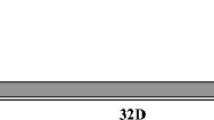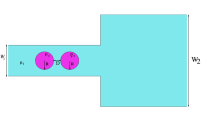Abstract
This study describes the numerical simulation of two-dimensional droplet formation and the following motion by using the Lattice Boltzmann Method (LBM) with the phase field equation. The free energy model is used to treat the interfacial force and the deformation of a binary fluid system, drawn into a cross-junction microchannel. While one fluid is introduced through the central inlet channel, the other fluid is drawn into the main channel through the two vertical inlet channels. Due to the effect of surface tension on the interface between the two fluids, the droplets of the first fluid are formed near the cross-junction. The aim in this investigation is to examine the applicability of LBM to the numerical analysis of the droplet formation and its motion in the microchannel. It was found from comparison with the experimentally visualized patterns that LBM with the free energy model can reproduce the droplet formation successfully. However because of the stability problem which is intrinsic for high surface-tension cases, it requires a very long computational time. This issue is to be resolved in the future.
Similar content being viewed by others
Abbreviations
- c :
-
Reference velocity
- E :
-
Error
- e :
-
Discrete particle velocity
- F :
-
Free-energy function
- f i :
-
Distribution function of the total density
- f i :
-
Distribution function of the total density after the collision process
- g i :
-
Distribution function of the density difference
- g i :
-
Distribution function of the density difference after the collision process
- P αβ :
-
Pressure tensor
- Δt :
-
Time step
- u :
-
Fluid velocity
- U in :
-
Maximum velocity at the horizontal inlet
- ũ j :
-
Normalized velocity
- u j :
-
Normalized exact solution
- V in :
-
Maximum velocity at the vertical inlet
- Δx:
-
Space step
- Γ:
-
Mobility coefficient of the fluids
- Δμ:
-
Chemical potential difference
- ξ:
-
Interfacial width
- ρ:
-
Total density of both fluids
- ρ a :
-
Density of fluid A
- ρ b :
-
Density of fluid B
- ρ *0 :
-
Reference density (dimensional)
- σ:
-
Surface tension at the interface
- ν:
-
Kinematic viscosity of both fluids
- φ:
-
Density difference between fluid A and B
- *:
-
Dimensional variable
- eq:
-
Equilibrium term
- a:
-
Fluid A
- b:
-
Fluid B
- i :
-
Link number
- in:
-
Inlet
References
Gunstensen, A. K., Rothman, D. H., Zaleski, A. and Zanetti, G., 1991, “Lattice Boltzmann Model of Immiscible Fluid,”Physical Review A, Vol. 43, pp. 4320–4327.
Kim, K. C., Kim, J. M. and Yoon, S. Y., 2004, “Simultaneous Measurement of Internal and External Flow Fields around the Droplet Formation in a Microchannel,”4th KSV Conference, Korea, pp. 80–83.
Nourgaliev, R. R., Dinh, T. N., Theofanous, T. G. and Joseph, D., 2003, “The Lattice Boltzmann Equation method: Theoretical Interpretation, Numerics and Implications,”Multiphase Flows, Vol. 29, pp. 117–169.
Orlandini, E., Swift, M.R. and Yeomans, J. M., 1995, “A Lattice Boltzmann Model of Binary-Fluid Mixtures,”Europhysics Letters, Vol. 32, No. 6, pp. 463–468.
Qian, D. Y., 2003,Bubble Motion, Deformation and Breakup in Stirred Tanks, Ph.D. Dissertation, Clarkson University, USA.
Shan, X. and Chen, H., 1993, “Lattice Boltzmann Model for Simulating Flows with Multiple Phases and Components,”Physical Review E, Vol. 47, pp. 1815–1819.
Succi, S., 2001,The Lattice Boltzmann Equation for fluid Dynamics and Beyond, Clarendon Press, Oxford
Suh, Y. K. and Kang, S. M., 2006, “Assessment of Algorithms for the No-Slip Boundary Condition in the Lattice Boltzmann Method,” (submitted)
Sukop, M. C. and Thorne, D. T., 2006,Lattice Boltzmann Modeling, Springer, The Netherlands
Swift, M. R., Orlandini, E., Osborn, W. R. and Yeomans, J. M., 1996, “Lattice Boltzmann Simulation of Liquid-Gas and Binary Fluid Systems,”Physical Review E, Vol. 54, No. 5, pp. 5041–5052.
Xu, A., Gonnella, G. and Lamura, A., 2003, “Phase-Separating Binary Fluids Under oscillatory Shear,”Physical Review E, Vol. 67, pp. 056105-1–056105-14.
Xu, A., Gonnella, G. and Lamura, A., 2004, “Phase Separation of Incompressible Binary Fluids with Lattice Boltzmann Methods,”Physical A, Vol. 331, pp. 10–22.
Yu, D. Z., Mei, R. W., Luo, L. S. and Shyy, W., 2003, “Viscous Flow Computations with the Method of Lattice Boltzmann Equation,”Progress in Aerospace Sci., Vol. 39, pp. 329–367.
Yuan, P., 2005,Thermal lattice Boltzmann two-phase flow model for fluid dynamics, Ph.D. Dissertation, University of Pittsburgh, USA.
Author information
Authors and Affiliations
Corresponding author
Rights and permissions
About this article
Cite this article
Li, Z., Kang, J., Park, J.H. et al. Numerical simulation of the droplet formation in a cross-junction microchannel using the Lattice Boltzmann Method. J Mech Sci Technol 21, 162–173 (2007). https://doi.org/10.1007/BF03161722
Received:
Revised:
Issue Date:
DOI: https://doi.org/10.1007/BF03161722




